2008 KIA Sportage heating
[x] Cancel search: heatingPage 248 of 350
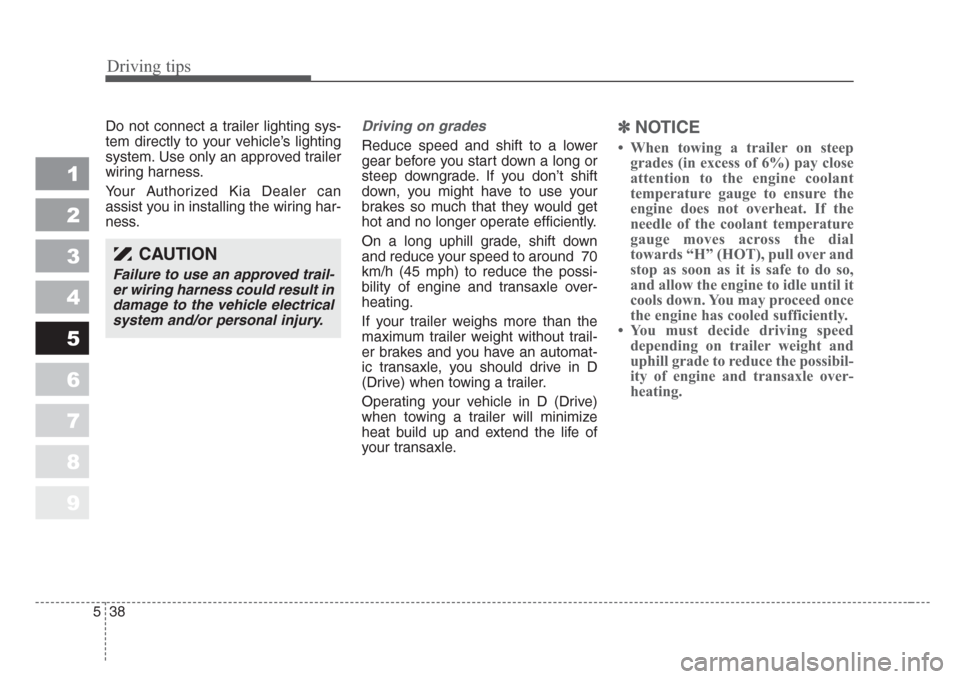
Driving tips
38 5
1
2
3
4
5
6
7
8
9
Do not connect a trailer lighting sys-
tem directly to your vehicle’s lighting
system. Use only an approved trailer
wiring harness.
Your Authorized Kia Dealer can
assist you in installing the wiring har-
ness.Driving on grades
Reduce speed and shift to a lower
gear before you start down a long or
steep downgrade. If you don’t shift
down, you might have to use your
brakes so much that they would get
hot and no longer operate efficiently.
On a long uphill grade, shift down
and reduce your speed to around 70
km/h (45 mph) to reduce the possi-
bility of engine and transaxle over-
heating.
If your trailer weighs more than the
maximum trailer weight without trail-
er brakes and you have an automat-
ic transaxle, you should drive in D
(Drive) when towing a trailer.
Operating your vehicle in D (Drive)
when towing a trailer will minimize
heat build up and extend the life of
your transaxle.
✽
NOTICE
• When towing a trailer on steep
grades (in excess of 6%) pay close
attention to the engine coolant
temperature gauge to ensure the
engine does not overheat. If the
needle of the coolant temperature
gauge moves across the dial
towards “H” (HOT), pull over and
stop as soon as it is safe to do so,
and allow the engine to idle until it
cools down. You may proceed once
the engine has cooled sufficiently.
• You must decide driving speed
depending on trailer weight and
uphill grade to reduce the possibil-
ity of engine and transaxle over-
heating.
CAUTION
Failure to use an approved trail-
er wiring harness could result in
damage to the vehicle electrical
system and/or personal injury.
Page 250 of 350
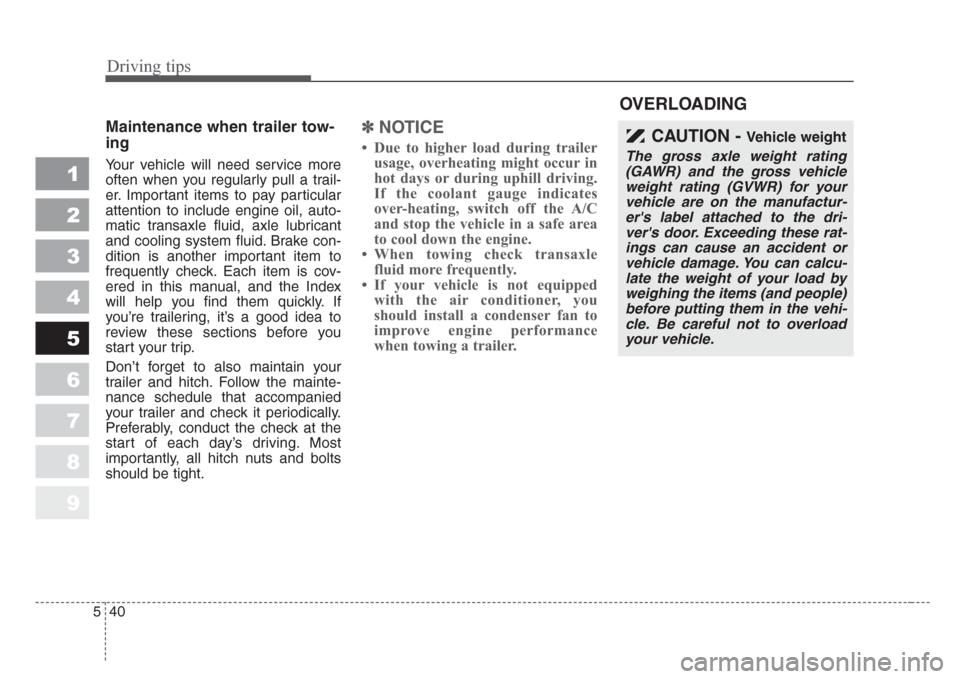
Driving tips
40 5
1
2
3
4
5
6
7
8
9
Maintenance when trailer tow-
ing
Your vehicle will need service more
often when you regularly pull a trail-
er. Important items to pay particular
attention to include engine oil, auto-
matic transaxle fluid, axle lubricant
and cooling system fluid. Brake con-
dition is another important item to
frequently check. Each item is cov-
ered in this manual, and the Index
will help you find them quickly. If
you’re trailering, it’s a good idea to
review these sections before you
start your trip.
Don’t forget to also maintain your
trailer and hitch. Follow the mainte-
nance schedule that accompanied
your trailer and check it periodically.
Preferably, conduct the check at the
start of each day’s driving. Most
importantly, all hitch nuts and bolts
should be tight.
✽
NOTICE
• Due to higher load during trailer
usage, overheating might occur in
hot days or during uphill driving.
If the coolant gauge indicates
over-heating, switch off the A/C
and stop the vehicle in a safe area
to cool down the engine.
• When towing check transaxle
fluid more frequently.
• If your vehicle is not equipped
with the air conditioner, you
should install a condenser fan to
improve engine performance
when towing a trailer.
OVERLOADING
CAUTION - Vehicle weight
The gross axle weight rating
(GAWR) and the gross vehicle
weight rating (GVWR) for your
vehicle are on the manufactur-
er's label attached to the dri-
ver's door.Exceeding these rat-
ings can cause an accident or
vehicle damage.You can calcu-
late the weight of your load by
weighing the items (and people)
before putting them in the vehi-
cle.Be careful not to overload
your vehicle.
Page 263 of 350
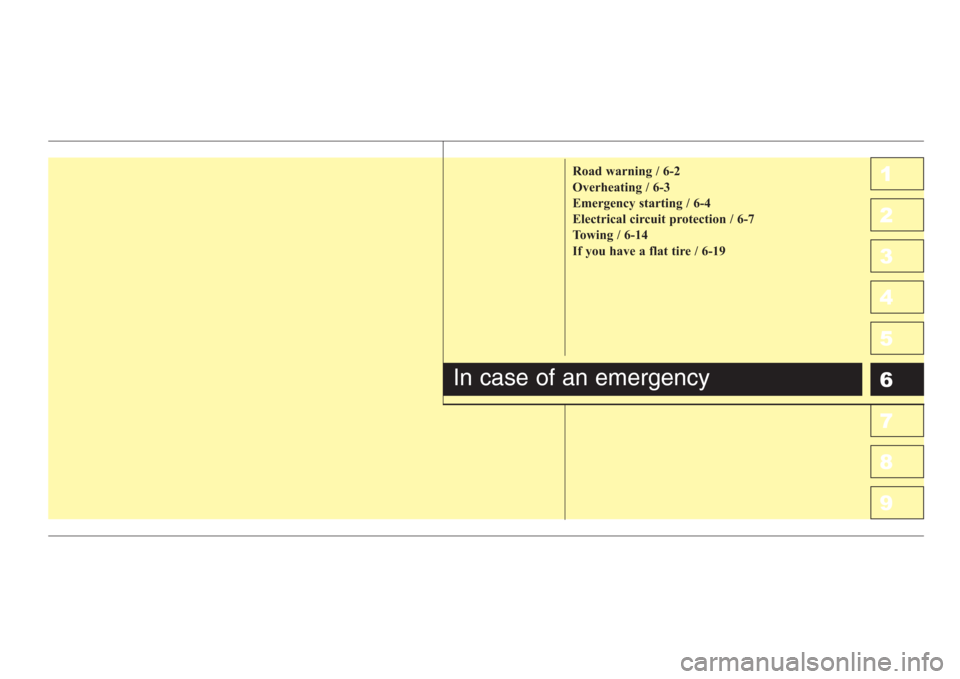
1
2
3
4
5
6
7
8
9Road warning / 6-2
Overheating / 6-3
Emergency starting / 6-4
Electrical circuit protection / 6-7
Towing / 6-14
If you have a flat tire / 6-19
In case of an emergency
Page 265 of 350

63
In case of an emergency
OVERHEATING
If your temperature gauge indicates
overheating, if you experience a loss
of power, or if you hear a loud knock-
ing or pinging noise, the engine has
probably overheated. Should any of
these symptoms occur, use the fol-
lowing procedure:
1. Turn on the hazard warning flash-
er, then drive to the nearest safe
location and stop your vehicle; set
the automatic transaxle in P
(Park), or shift the manual
transaxle to N (Neutral) and apply
the parking brake.
2. Make sure the air conditioner is
off.
3. If coolant or steam is boiling out of
the radiator, stop the engine and
call an Authorized Kia Dealer for
assistance.If coolant is not boiling out, allow
the engine to idle and open the
hood to permit the engine to cool
gradually.
If the temperature does not go
down with the engine idling, stop
the engine and allow sufficient
time for it to cool.
4. The coolant level should then be
checked. If the level in the reser-
voir is low, look for leaks at the
radiator hoses and connections,
heater hoses and connections,
radiator, and water pump. If you
find a major leak or another prob-
lem that may have caused the
engine to overheat, do not operate
the engine until it has been cor-
rected. Call an Authorized Kia
Dealer for assistance. If you do not
find a leak or other problem, care-
fully add coolant to the reservoir.
If the engine frequently overheats,
have the cooling system checked
and repaired by an Authorized Kia
Dealer.
1
2
3
4
5
6
7
8
9
WARNING- Removing
radiator cap
Do not remove the radiator cap
when the engine and radiator
are hot.Scalding hot coolant
and steam may blow out under
pressure.This could cause seri-
ous injury.
Page 315 of 350
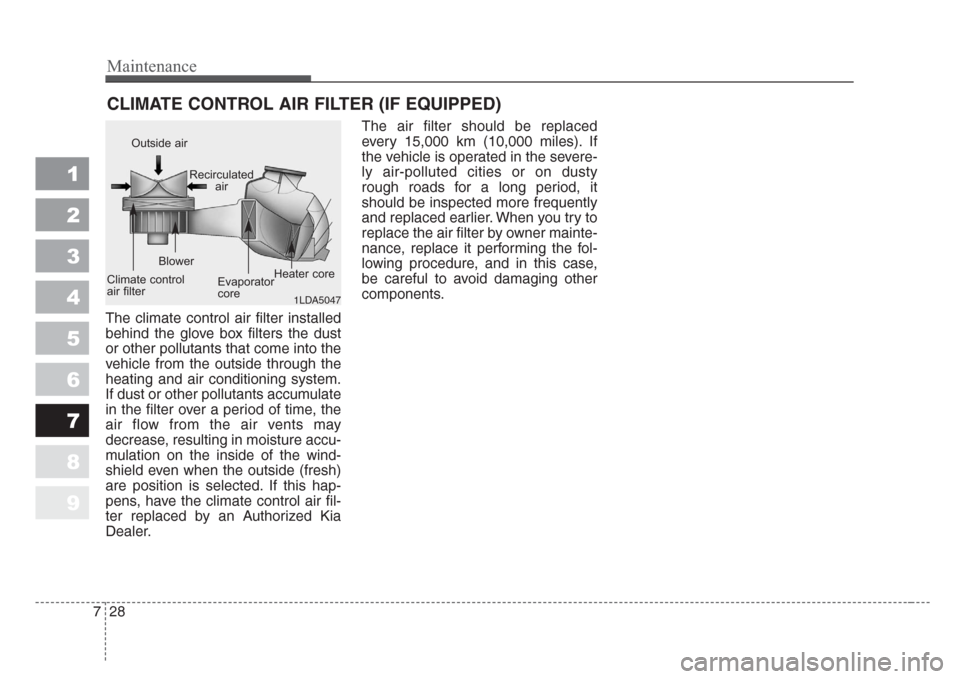
Maintenance
28 7
1
2
3
4
5
6
7
8
9
CLIMATE CONTROL AIR FILTER (IF EQUIPPED)
The climate control air filter installed
behind the glove box filters the dust
or other pollutants that come into the
vehicle from the outside through the
heating and air conditioning system.
If dust or other pollutants accumulate
in the filter over a period of time, the
air flow from the air vents may
decrease, resulting in moisture accu-
mulation on the inside of the wind-
shield even when the outside (fresh)
are position is selected. If this hap-
pens, have the climate control air fil-
ter replaced by an Authorized Kia
Dealer.The air filter should be replaced
every 15,000 km (10,000 miles). If
the vehicle is operated in the severe-
ly air-polluted cities or on dusty
rough roads for a long period, it
should be inspected more frequently
and replaced earlier. When you try to
replace the air filter by owner mainte-
nance, replace it performing the fol-
lowing procedure, and in this case,
be careful to avoid damaging other
components.
1LDA5047
Outside air
Recirculated
air
Climate control
air filterBlower
Evaporator
coreHeater core
Page 349 of 350
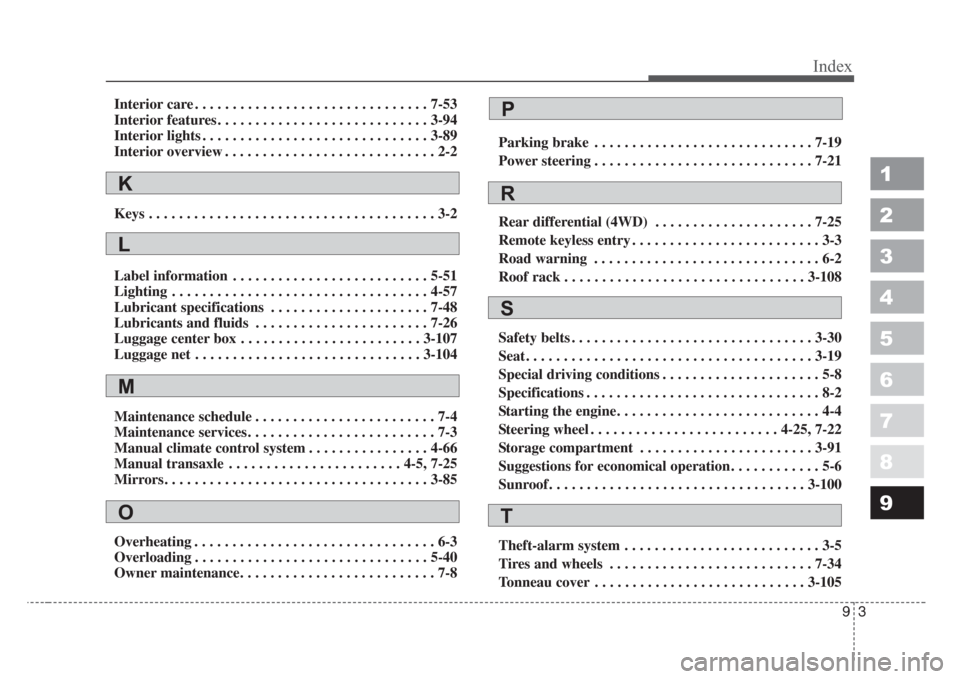
93
1
2
3
4
5
6
7
8
9
Index
Interior care . . . . . . . . . . . . . . . . . . . . . . . . . . . . . . . 7-53
Interior features . . . . . . . . . . . . . . . . . . . . . . . . . . . . 3-94
Interior lights . . . . . . . . . . . . . . . . . . . . . . . . . . . . . . 3-89
Interior overview . . . . . . . . . . . . . . . . . . . . . . . . . . . . 2-2
Keys . . . . . . . . . . . . . . . . . . . . . . . . . . . . . . . . . . . . . . 3-2
Label information . . . . . . . . . . . . . . . . . . . . . . . . . . 5-51
Lighting. . . . . . . . . . . . . . . . . . . . . . . . . . . . . . . . . . 4-57
Lubricant specifications . . . . . . . . . . . . . . . . . . . . . 7-48
Lubricants and fluids . . . . . . . . . . . . . . . . . . . . . . . 7-26
Luggage center box . . . . . . . . . . . . . . . . . . . . . . . . 3-107
Luggage net . . . . . . . . . . . . . . . . . . . . . . . . . . . . . . 3-104
Maintenance schedule . . . . . . . . . . . . . . . . . . . . . . . . 7-4
Maintenance services. . . . . . . . . . . . . . . . . . . . . . . . . 7-3
Manual climate control system . . . . . . . . . . . . . . . . 4-66
Manual transaxle . . . . . . . . . . . . . . . . . . . . . . . 4-5, 7-25
Mirrors. . . . . . . . . . . . . . . . . . . . . . . . . . . . . . . . . . . 3-85
Overheating. . . . . . . . . . . . . . . . . . . . . . . . . . . . . . . . 6-3
Overloading. . . . . . . . . . . . . . . . . . . . . . . . . . . . . . . 5-40
Owner maintenance. . . . . . . . . . . . . . . . . . . . . . . . . . 7-8Parking brake . . . . . . . . . . . . . . . . . . . . . . . . . . . . . 7-19
Power steering. . . . . . . . . . . . . . . . . . . . . . . . . . . . . 7-21
Rear differential (4WD) . . . . . . . . . . . . . . . . . . . . . 7-25
Remote keyless entry . . . . . . . . . . . . . . . . . . . . . . . . . 3-3
Road warning. . . . . . . . . . . . . . . . . . . . . . . . . . . . . . 6-2
Roof rack . . . . . . . . . . . . . . . . . . . . . . . . . . . . . . . . 3-108
Safety belts . . . . . . . . . . . . . . . . . . . . . . . . . . . . . . . . 3-30
Seat . . . . . . . . . . . . . . . . . . . . . . . . . . . . . . . . . . . . . . 3-19
Special driving conditions . . . . . . . . . . . . . . . . . . . . . 5-8
Specifications . . . . . . . . . . . . . . . . . . . . . . . . . . . . . . . 8-2
Starting the engine. . . . . . . . . . . . . . . . . . . . . . . . . . . 4-4
Steering wheel . . . . . . . . . . . . . . . . . . . . . . . . . 4-25, 7-22
Storage compartment . . . . . . . . . . . . . . . . . . . . . . . 3-91
Suggestions for economical operation . . . . . . . . . . . . 5-6
Sunroof . . . . . . . . . . . . . . . . . . . . . . . . . . . . . . . . . . 3-100
Theft-alarm system . . . . . . . . . . . . . . . . . . . . . . . . . . 3-5
Tires and wheels . . . . . . . . . . . . . . . . . . . . . . . . . . . 7-34
Tonneau cover . . . . . . . . . . . . . . . . . . . . . . . . . . . . 3-105
K
L
M
O
P
R
S
T